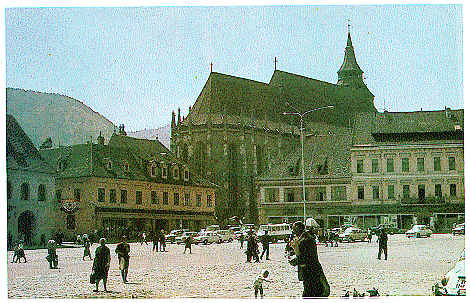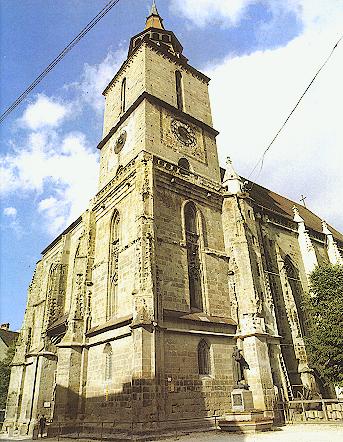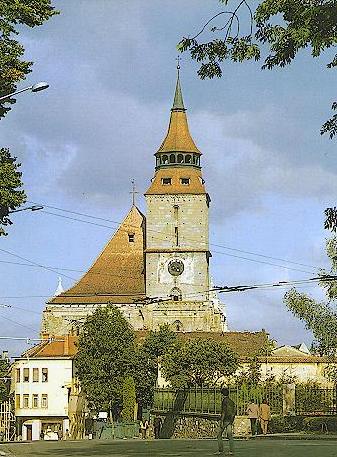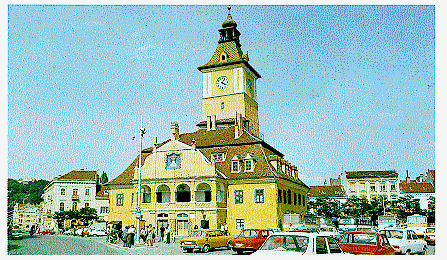BASSÓ After the Hungarian
Conquest of Transylvania in 896,
BASSÓ After the Hungarian Conquest of Transylvania in 896, Brassó became
a Hungarian village. Saint Stephen I (1000-1038), the first Hungarian king, built a
royal fortress and a church, called Brassovia on the hill-top of Cenk; the hill with a
cable-car service today, near downtown Brassó (Brasov, Rumania today). In 1211,
the German Knight Order settled in Brassó, and although they were ousted in 1225
by Hungarian king András II, Brassó never stopped developing quickly. In a
document, issued on March 10, 1471, by Hungarian king Matthias (1458-1490), the
renaissance king, Brassó was awarded a number of privileges. In the same
document, the king speaks about the town with admiration, saying "...Brassó, lying
in the land of Barcaság, is an outpost, the easternmost gate to our country; it
is so shiny, such a gem...".
Brassó became the richest and most developed Saxon commercial city in
Transylvania.
The Old City Hall of Brassó was built in 1420. The building, which originally
housed the head office of the town's shop holders council, was expanded between
1515-1528 in gothic style, and between 1770-1774 in baroque style. On the front
wall of the old City Hall, which has a 58-meters-high tower, the coat of arms of the
Coronation town can be seen depicting a crown from which roots are growing.
The Black Church is Transylvania's most majestic church, which is also the largest
and finest gothic church in easternmost Europe. Other great Saxons centres, such as
Berethalom, Szászsebes, Segesvár, etc., underlines the fact that the strategy by the
Hungarian kings to bring in Transylvania the Saxons from Germany to add to and
replenish the culture here was good for the country.
The construction of the church started in 1383 and lasted one hundred years. When
Caraffa, the sadistic military leader in Habsburg pay, cracked down on Brassó in
1689, he set the entire city on fire. In the burning inferno turned the walls of the
church black, giving it the name the Black Church. The 88-meter-long,
23-meter-wide, 3-aisle church has 21-meter-high walls supported by buttresses
which end in pinnacles. Originally two towers were designed but only one built,
which is 65-meter-high, and hosts a bell which weighs 6 tons! The church has 5
porches which still have the original oak-tree doors, counting 500 years. Above the
southern porch, a renaissance fresco shows the coat of arms of Hungarian king
Matthias and his wife Beatrix. The apse also has 3 aisles, the pews were built in
1710-1714, and the altar dates 1866. The treasury of the church holds items, such as
a bronze baptismal tub from 1472, and 119 Oriental carpets which are the donations
of the wealthy Saxon dealers. An organ with 4000 pipes and 76 registers, made in
1839, makes this mighty cathedral a complete and wonderful masterpiece of human
art.
Brassó, similarly to other towns in Transylvania, had a complex system of defense
walls with towers and gates. Using the stones of the old fortress built by Saint
Stephen I, they started to build the city walls in the 15th century. The huge wall
system had 28 towers and 7 bastions, and it was so strong that Brassó could
successfully defend itself against the Tartar attacks. From the gates of the walls,
only the Katalin Gate is left today, which was built in the 16th century.
PICTURES OF THE "FEKETE TEMPLOM( The Black Church)
(It burned down in 1689 and left the walls black. This gave it it's Name)



BRASSO

Go to my Picture Page
RETURN HOME




